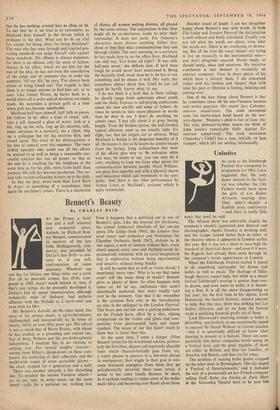Bennett's Beauty
By CHARLES REID
Mr. Bennett's Aubade, on the other hand, like most of his serious music, is up-to-the-minute, challengingly and resourcefully so, in terms of twenty, thirty or even fifty years ago. His school is not so much that of Pierre Boulez, with whom he has studied, as a preceding and related one, that of Berg, Webern and the pre-dodecaphonic Schoenberg. I mention this in no twitting or carping way. For several weighty reasons— among them Hitler's clamp-down on these com- posers, his scattering of their adherents and the world-wide vogue of more accessible idioms— the clock stopped for a generation and a half.
There was another obstacle, a less disturbing one. To emulate the second Viennese school— or, at any rate, to write music up the same `street'- calls for a patrician ear, nothing less.
Now it happens that a patrician ear is one of Bennett's gifts. Like the Journal for Orchestra, the central orchestral interlude of his one-act opera The Ledge (both 1961), the London Pas- toral (tenor and orchestra) and Nocturnes for Chamber Orchestra (both 1962), Aubade is, in one aspect, a web of timbres without flaw, every chord spaced, every tune and rhythmic-motif in- strumentally coloured, with an aural imagination that is explorative without being experimental and sensitive without being finicky.
It will be noted that as well as 'every chord,' I mentioned 'every tune.' Who is to say that tunes aren't still the main thing in music? Bennett gives us plenty of them. As often happens with tunes—or, let us say, melismata—that aren't diatonically anchored, they don't readily take root in the memory. One that I do remember is the cerulean flute solo in the introduction (as also in the epilogueY to the London Pastoral. This floats and unfolds over a pulsing pedal-note on the French horn, offset by a slim, sighing countertune on the violins and glints and tone- particles from glockenspiel, harp and tuned- cymbals. The music of our day hasn't much to show that is fairer than this.
At the same time, I sense a danger. Often Bennett writes for his woodwind soloists, particu- larly the first oboe, elegant and supremely playable tunes which characteristically pass from, say, a triplet phrase in quavers to a five-note phrase in semiquavers, then wiggle to their goal in win- some demisemi arpeggios. Even when they get polyphonically involved, these tunes retain, it seems to me, some family likeness. In short, he is perhaps tending to repeat some of his melis- matic ideas and becoming over-fluent about them.
Another touch of doubt. I am not altogether happy about Bennett's way with words. In both The Ledge and London Pastoral the declamation is well ordered and finely calculated. Usually you can tell what the words are about, even what the words are. There is no overlaying or drown- ing. But all the time the vocal 'shapes' are trying to live up musically to the instrumental ones— and don't altogether succeed. Words imply, or should imply, ideas and emotions. My tentative conclusion is that Bennett is essentially an abstract composer. Even in those pieces of his which have a literary basis, I am concerned rather with his timbres and 'shapes' than with what his poet or librettist is feeling, thinking and putting over.
One of the nice things about Bennett is that he sometimes takes off his neo-Viennese harness and writes pop-jazz. His recent Jazz Calendar, morrow sound-track. The sixth movement suite for twelve-piece band based on the nur- sery-rhyme: 'Monday's child is fair of face,' etc. The vein, debonair-to-blue, makes me think of John Lewis's remarkable Odds Against To- morrow sound-track. The sixth movement (`Saturday's Child') has a tune, initially on bass trumpet, which left me smiling infatuatedly.


































 Previous page
Previous page